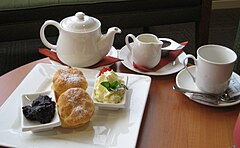Devonshire Tea

|
|
| Alternative names | Devonshire tea, Cornish cream tea |
|---|---|
| Place of origin | England |
| Region or state | South West England |
| Serving temperature | Tea: hot Scones: warm Jam & cream: ambient |
| Main ingredients | Tea, scones, clotted cream, strawberry jam |
| Variations | Multiple |
| High kcal | |
| |
|
A cream tea (also known as a Devonshire tea, Devon cream tea or Cornish cream tea) is a form of afternoon tea light meal, consisting of tea taken with a combination of scones, clotted cream, and jam. Traditionally a speciality of Devon and Cornwall, cream teas are offered for sale in tea rooms in those two counties, as well as in other parts of England, and elsewhere in the Commonwealth.
The name "Devonshire tea" comes from the county of Devon in England. The exact origin of "cream tea" is disputed, although there is evidence to suggest that the tradition of eating bread with cream and jam already existed at in Devon in the 11th century. The earliest use of "cream tea" in the sense of this article (as opposed to a cup of tea with cream in it) that the OED can find is in 1964 "Picture of Millie" by Philip Maitland Hubbard which has; "We just bathe and moon about and eat cream teas." The "Foods of England" website has discovered a newspaper cutting - 'The Cornishman' of Thursday 3 September 1931 (p8) - which uses the phrase in its modern sense.
There are regional variations as to how a cream tea should preferably be eaten. The Devonshire (or Devon) method is to split the scone in two, cover each half with clotted cream, and then add strawberry jam on top. Traditionally it is important that the scones be warm (ideally, freshly baked), and that clotted (rather than whipped) cream and strawberry jam, rather than any other variety, are used. Butter is generally not included, and some sources advise that the tea should not be served with milk. The Devon method is also commonly used in the neighbouring counties of Somerset, Hampshire and the Isle of Wight.
In Cornwall, the cream tea was traditionally served with a "Cornish split", a type of slightly sweet white bread roll, rather than a scone. It is now rare to find this available commercially, even in Cornwall, but splits are still used by many Cornish families in their own homes. The warm roll (or scone) is first buttered, then spread with strawberry jam, and finally topped with a spoonful of clotted cream. Scones are rarely buttered in commercially available teas.
...
Wikipedia
